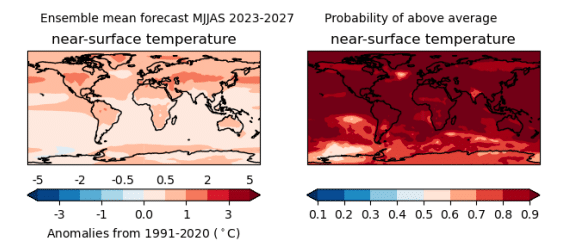The latest WMO assessment suggests a 66% chance that rising global emissions and changing weather patterns will lead to global temperatures exceeding the critical 1.5C limit, leading to irreversible changes to the planet.
—
There is a 66% chance that the world will breach the critical 1.5C global warming threshold in the next four years, owing to a rise in anthropogenic carbon emissions and an imminent El Niño weather pattern expected later this year, the UN has warned.
In the latest annual climate update published Wednesday, the World Meteorological Organization (WMO) also suggested a 98% chance of at least one year between now and 2027 exceeding history’s warmest year on record, 2016, which happened after an “exceptionally strong” El Niño event. Indeed, the El Niño Southern Oscillation expected between December and February next year, a phenomenon that pushes more heat up from the oceans into the atmosphere, will push global temperatures off the charts, resulting in unprecedented heatwaves.

Annual mean anomaly predictions for 2023 relative to 1991-2020. Ensemble mean (left column) for temperature (°C). Source: WMO.

Predictions for 2023-2027 May to September anomalies relative to 1991-2020. Ensemble mean (left column) for temperature (°C). Source: WMO.
Professor Adam Scaife, the head of a long-range prediction at the UK Met Office, said that the impacts of El Niño events are going to get stronger and so will the effects of climate change itself: “You put those two things together, and we are likely to see unprecedented heatwaves during the next [event],” he told the Guardian.
“This report does not mean that we will permanently exceed the 1.5C limit specified in the Paris Agreement which refers to long-term warming over many years,” said WMO Secretary-General Prof. Petteri Taalas. “However, WMO is sounding the alarm that we will breach the 1.5C level on a temporary basis with increasing frequency.”
Scientists behind the WMO report also analysed the likely impacts of rising temperatures. A study published last year suggested that, in the last 43 years, the Arctic has warmed nearly four times faster than the rest of the planet. Now, the new WMO report warns that the polar region will experience warming at a greater level than many areas around the world, with the temperature anomaly expected to be three times as large as the global figure over the next five northern hemisphere winters.
The report also warned that Northern Eurasia will likely experience increased rainfall for the May to September period over the next five years.
Speaking to the BBC, UK Met Office expert scientist Dr Leon Hermanson, who led the report, warned that nobody will be untouched by the changes happening, such as floods and droughts.
“Global temperatures are predicted to continue increasing, moving us further and further away from the climate we are used to,” he said.
The study is just the latest warning from the scientific community. In a report published late last year, the UN had already warned that the world is on track to warm well above 2C.
Global temperatures have already risen at least 1.1C since pre-industrial levels. Beyond the 1.5C average global temperature rise limit agreed upon by nations worldwide in the 2015 Paris Agreement, scientists forecast that irreversible changes to the planet will occur.
You might also like: El Niño Will Push Global Temperatures ‘Off the Chart’ in 2023, Scientists Warn


















